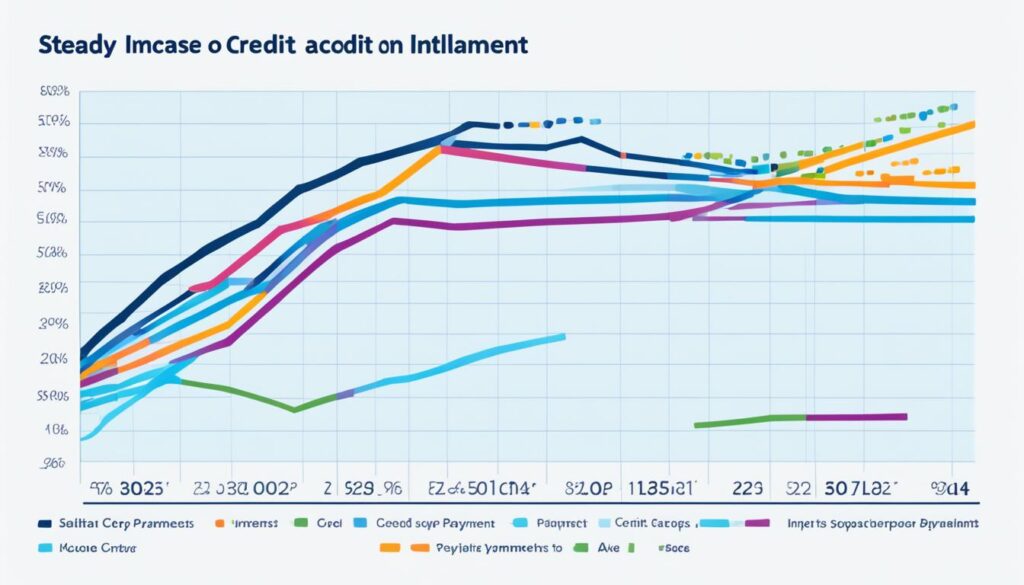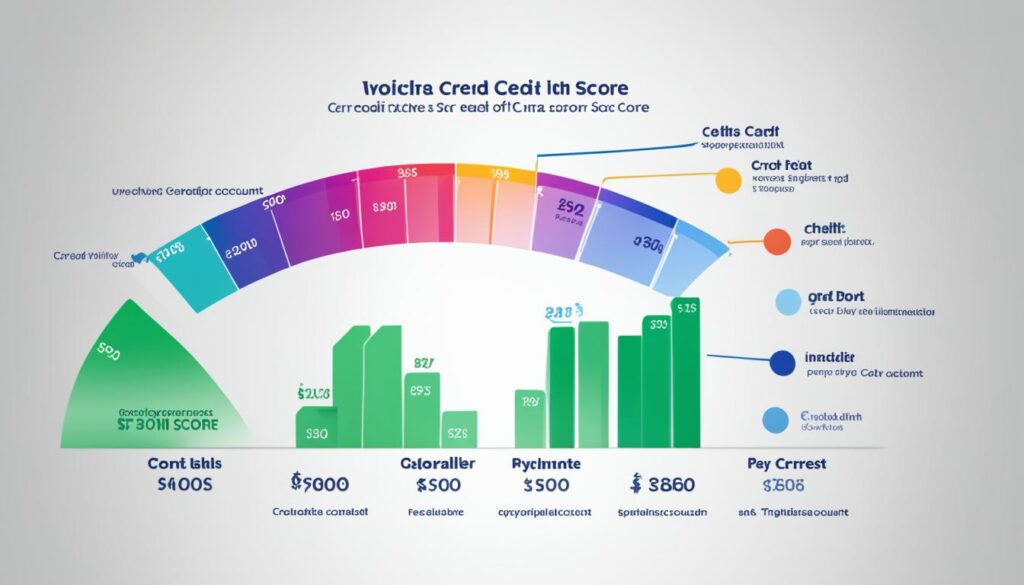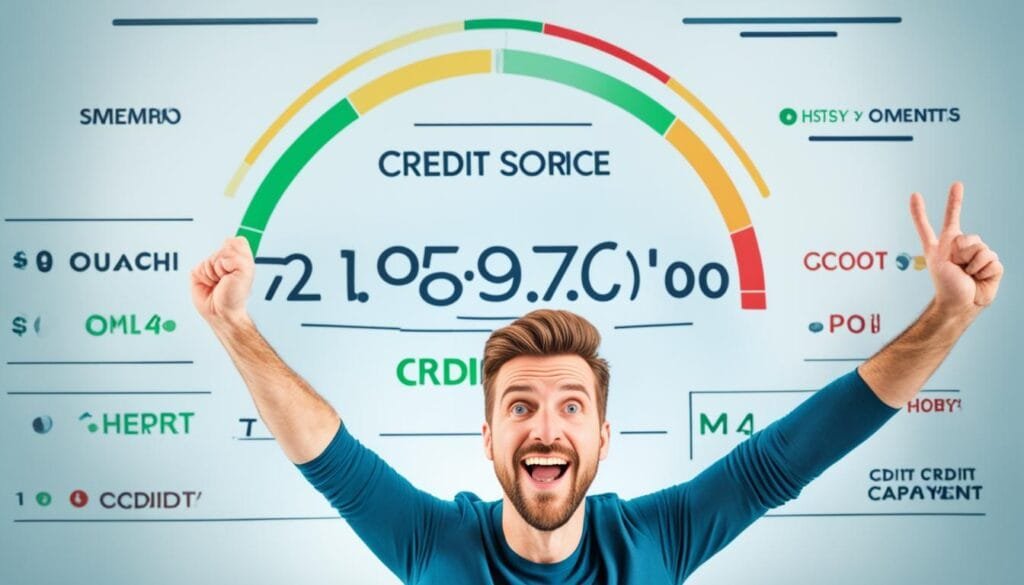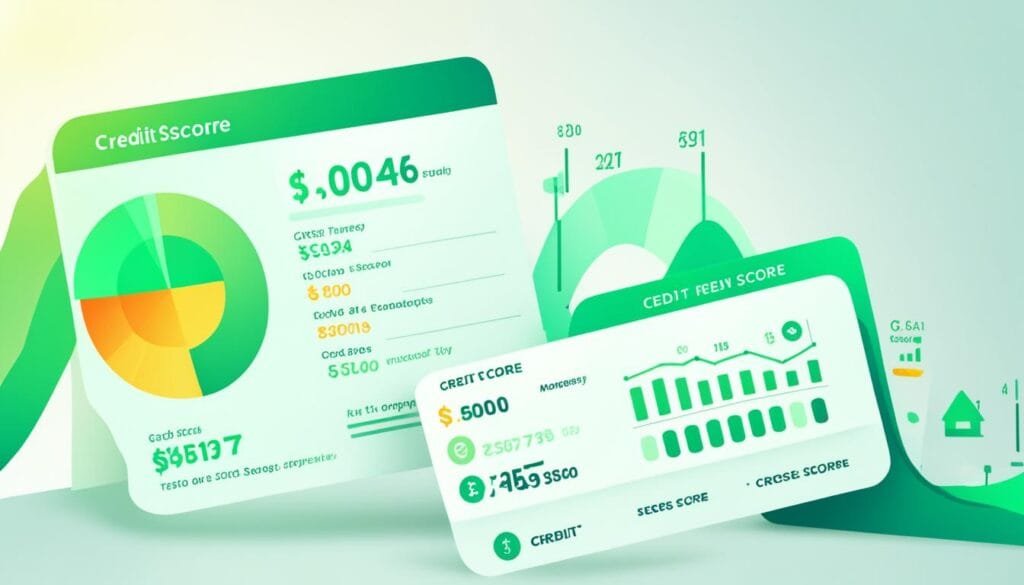Credit accounts play a significant role in our financial lives, allowing us to access funds when we need them and pay them back later. It’s essential to understand the different types of credit accounts available and how they can impact our credit scores. In this article, we will explore the various types of credit accounts, including credit card accounts, mortgage accounts, personal loan accounts, auto loan accounts, student loan accounts, home equity line of credit accounts, business loan accounts, secured credit accounts, and unsecured credit accounts.
Key Takeaways:
- There are three main types of credit accounts: revolving credit, open-end credit, and installment credit.
- Revolving credit accounts include credit card accounts and home equity lines of credit accounts.
- Open-end credit accounts can be seen in charge cards and collection accounts.
- Installment credit accounts are found in mortgages, personal loans, auto loans, and student loans.
- Each type of credit account can impact your credit score differently, depending on factors like payment history, credit utilization ratio, and credit mix.
Revolving Credit Accounts
Revolving credit accounts provide borrowers with the flexibility to access funds up to a predetermined credit limit and make repayments based on their usage. These accounts offer a convenient way to manage expenses, with the ability to borrow and repay as needed. Two common examples of revolving credit accounts are credit cards and home equity lines of credit (HELOC).
Credit card accounts:
Credit cards are a popular form of revolving credit. They provide users with a line of credit that can be used to make purchases or pay bills. With numerous options available, credit cards offer different types of rewards and interest rates to suit individual preferences. Whether you’re looking for cashback, travel rewards, or low APRs, credit cards provide a range of choices to meet your financial needs.
Home equity line of credit accounts:
Homeowners can also access funds using a home equity line of credit (HELOC). This type of revolving credit account allows borrowers to tap into the equity they have built in their homes. By using the home as collateral, HELOCs offer lower interest rates compared to other forms of revolving credit. It’s important to note that with HELOCs, the available credit limit is determined by the equity in the property.
Benefits of Revolving Credit Accounts
- Flexible access to funds
- Ability to borrow and repay as needed
- Convenient for managing day-to-day expenses
- Opportunity to earn rewards and benefits
- Options for lower interest rates
Considerations for Managing Revolving Credit Accounts
While revolving credit accounts offer flexibility, it’s important to use them responsibly to maintain financial well-being. Here are a few considerations:
- Monitor credit utilization: Keeping your credit utilization ratio low can positively impact your credit score. Aim to keep your balances below 30% of your available credit limit.
- Make timely payments: Paying your credit card bills and HELOC payments on time helps establish a positive payment history.
- Review interest rates and fees: Understand the interest rates, fees, and terms associated with your revolving credit accounts to make informed decisions.
- Avoid unnecessary debt: Use revolving credit accounts responsibly and avoid accumulating unnecessary debt that may impact your financial stability.
By understanding how revolving credit accounts like credit cards and HELOCs work, and using them responsibly, you can effectively manage your finances and make the most of the benefits they offer.
| Credit Card | HELOC | |
|---|---|---|
| Access to funds | Instant access to a line of credit | Access funds based on available equity |
| Interest rates | Variable interest rates, depending on the card | Lower interest rates compared to credit cards |
| Credit limit | Determined by the card issuer | Determined by the available home equity |
| Repayment terms | Minimum monthly payment or full balance | Interest-only payments or repayment period |
| Collateral | No collateral required | Home serves as collateral |
Open-End Credit Accounts
When it comes to credit accounts, open-end credit offers borrowers the flexibility to borrow and repay funds repeatedly without a set end date. Two common examples of open-end credit accounts are charge cards and collection accounts.
Charge cards function like credit cards but come with one major difference. Instead of allowing borrowers to carry a balance over time, charge cards require the balance to be paid in full each month to avoid fees or penalties. This structure promotes responsible spending habits and prevents the accumulation of long-term debt.
While collection accounts are not typically associated with open-end credit, they can fall under this category if the past-due balance needs to be paid in full. Collection accounts occur when a borrower fails to repay debts and the creditor hands over the debt to a collection agency. These agencies, acting on behalf of the creditor, then try to recover the full outstanding balance.
“Open-end credit accounts like charge cards provide a convenient way to make daily purchases while maintaining financial discipline by requiring full balance repayment each month.”
Understanding the intricacies of open-end credit accounts is essential in effectively managing one’s financial resources. Maintaining timely payments and keeping balances in check are crucial for individuals seeking to build a positive credit history and maintain a healthy credit score.
Pros and Cons of Open-End Credit Accounts
While open-end credit accounts offer flexibility and convenience, it’s important to consider the pros and cons before committing to them.
| Pros | Cons |
|---|---|
| 1. No set end date | 1. Requires full balance repayment |
| 2. Flexible borrowing and repayment | 2. High potential for debt accumulation |
| 3. Can help build credit history | 3. May carry high interest rates |
By weighing the advantages and disadvantages, individuals can make informed decisions when considering open-end credit accounts like charge cards or collection accounts.
Installment Credit Accounts
When it comes to borrowing money, installment credit accounts provide a structured and predictable repayment plan. With installment credit, you borrow a fixed amount of money and repay it in equal monthly installments over a set term. This type of credit is commonly used for major expenses, such as purchasing a home, financing a vehicle, or funding education.
Let’s take a closer look at some common examples of installment credit accounts:
- Mortgages: Mortgages are installment loans used to finance the purchase of homes. They typically have longer terms and lower interest rates compared to other types of installment loans. Having a mortgage can be a smart investment in your future, as it allows you to build equity in your home over time.
- Personal Loans: Personal loans are versatile installment credit accounts that can be used for various purposes. Whether you’re consolidating debt, remodeling your home, or funding a special event, a personal loan provides you with the funds you need. Interest rates for personal loans can vary depending on factors such as your credit score and the loan amount.
- Auto Loans: If you’re in the market for a new or used vehicle, an auto loan can help you finance your purchase. Auto loans are installment credit accounts that allow you to make monthly payments over a predetermined period. The interest rates and terms of auto loans can vary based on factors such as your credit history, the vehicle’s value, and the loan duration.
- Student Loans: Student loans are installment credit accounts specifically designed to help students fund their education. Whether you’re pursuing a bachelor’s degree or attending graduate school, student loans can provide financial support. These loans often offer favorable interest rates and flexible repayment terms to accommodate students’ needs.
Each of these installment credit accounts serves a unique purpose and can have a significant impact on your financial journey. It’s important to carefully consider your options, evaluate the terms and conditions, and choose the installment credit account that aligns with your goals.
The Benefits of Installment Credit Accounts
Installment credit accounts offer several advantages over other forms of credit. Here are some key benefits:
- Structured Repayment: With installment credit, you have a clear repayment plan from the start. Knowing exactly how much you’ll owe each month makes budgeting easier.
- Controlled Debt: Since you borrow a specific amount, installment credit can help you avoid excessive debt accumulation. By repaying the loan in fixed installments, you have a clear path towards reducing your debt.
- Improved Credit Mix: Having a diverse mix of credit accounts, including installment credit, can positively impact your credit score. Lenders consider your credit mix when assessing your creditworthiness, so having a responsible history with installment credit accounts can boost your overall credit profile.
By understanding the advantages of installment credit accounts and selecting the appropriate one for your needs, you can take control of your finances and achieve your goals.

“Installment credit accounts provide a structured and manageable way to finance life’s major expenses. From buying a home to funding education, installment credit ensures you have a clear repayment plan.”
How Different Types of Credit Affect Credit Scores
Understanding how different types of credit accounts impact your credit score is essential for maintaining a healthy financial profile. Each type of credit account, whether it’s revolving credit, open-end credit, or installment credit, can have a different effect on your creditworthiness and overall credit score.
Firstly, let’s discuss revolving credit accounts, such as credit card accounts. These accounts can influence your credit utilization ratio, which measures the amount of available credit you’re using. Keeping your credit card balances low compared to your credit limits demonstrates responsible credit management and can positively impact your credit score. Additionally, your payment history on revolving credit accounts is crucial. Making on-time payments consistently shows lenders that you’re a reliable borrower.
Open-end credit accounts, like charge cards, can also influence your credit scores. When you make timely payments on these accounts, it reflects positively on your credit history. Charge cards, in particular, require you to pay the balance in full each month, which can contribute to a positive payment history and credit score.
Installment credit accounts, on the other hand, provide a different set of factors that impact your credit score. Mortgages, personal loans, auto loans, and student loans are common examples of installment credit accounts. Managing these accounts responsibly, making your monthly payments on time, and keeping your balances low can greatly improve your credit score. Additionally, having a mix of installment credit accounts can diversify your credit profile and demonstrate your ability to handle different types of credit.
It’s important to note that the impact of each type of credit on your credit score will vary depending on various factors. Your payment history, credit utilization ratio, credit mix, and length of credit history all play a role in determining your creditworthiness. Managing all types of credit responsibly is key to maintaining a good credit score.

| Type of Credit Account | Impact on Credit Score |
|---|---|
| Revolving Credit (Credit Card Accounts) | Affects credit utilization ratio and payment history |
| Open-End Credit (Charge Cards) | Positive impact through on-time payments |
| Installment Credit (Mortgages, Personal Loans, Auto Loans, Student Loans) | Improves credit mix and payment history |
How Does the Length of Credit History Impact Different Types of Credit Accounts?
When it comes to understanding credit history impact, the length of credit history can have varying effects on different types of credit accounts. For example, a longer credit history can positively impact revolving credit accounts, while installment loan accounts may be less influenced by the length of credit history.
Conclusion
In conclusion, understanding the different types of credit accounts is crucial for managing your financial health and credit score. By having a mix of revolving, open-end, and installment credit accounts, you can demonstrate to lenders your ability to handle different types of credit.
Responsibly managing your credit accounts, making on-time payments, and keeping your credit utilization ratio low can help improve your credit score and overall financial well-being. It’s important to monitor your credit accounts regularly, review your credit reports for accuracy, and take steps to correct any errors or discrepancies.
Remember, your credit score is a key factor that lenders use to determine your creditworthiness. A higher credit score can give you access to better interest rates and loan terms. By being proactive and knowledgeable about your credit accounts, you can take control of your financial future and achieve your goals.
FAQ
What are the different types of credit accounts?
The different types of credit accounts include credit card accounts, mortgage accounts, personal loan accounts, auto loan accounts, student loan accounts, home equity line of credit accounts, business loan accounts, secured credit accounts, and unsecured credit accounts.
What are revolving credit accounts?
Revolving credit accounts, such as credit card accounts and home equity line of credit accounts, allow borrowers to access funds up to a certain credit limit and make repayments based on their usage.
What are open-end credit accounts?
Open-end credit accounts, like charge cards and collection accounts, allow borrowers to borrow and pay back funds repeatedly, often with no end date.
What are installment credit accounts?
Installment credit accounts involve borrowing a fixed amount of money and repaying it in equal monthly payments over a set term. Examples include mortgages, personal loans, auto loans, and student loans.
How do different types of credit affect credit scores?
Different types of credit accounts can impact credit scores differently. Factors such as payment history, credit utilization ratio, and credit mix influence your creditworthiness.
How can I improve my credit score?
To improve your credit score, it’s important to manage all types of credit responsibly. This includes making on-time payments, keeping credit utilization ratios low, and maintaining a good credit mix.

